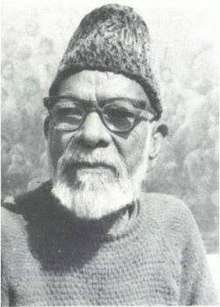Allah Bakhsh (painter)
Ustad Allah Bakhsh[lower-alpha 1] (c. 1895 – 18 October 1978) was a Pakistani painter and calligrapher who was actively involved in aesthetics and classical landscape paintings throughout his life. He produced his work in British India before partition and in Pakistan after split of Indian subcontinent. Most of his work revolves around traditional tales of Persian and Hindu mythology. He also depicted rural life, particularly culture of Punjab, Pakistan in his paintings.[2]
Allah Bakhsh | |
|---|---|
 | |
| Born | c. 1895 Wazirabad, Pakistan |
| Died | October 18, 1978 (aged 82–83) Pakistan |
| Nationality | Pakistani |
| Known for | Painting, Calligraphy [1] |
| Awards | Pride of Performance |
The recipient of national literary award, the Pride of Performance, he is primarily recognized for depicting tragic love stories of Sohni Mahiwal, Sohni Dharti, Heer Ranjha and Tilism-e-Hoshruba, an epic story of Amir Hamza, a legendary Persian adventurer. Sometimes, he used to depict traditional festivals of Punjab. Some of his work he produced after independence was acquired by the National Art Gallery.[3]
Life and background
He was born around 1895 in British India (in modern-day Wazirabad, Pakistan). He spent most of his life in Lahore. At first, he attended a Madrasa to study Urdu and Arabic, however, he subsequently left school. His father was a house painter who used to work at Mughalpura Railway Workshop.
Career
At the apparent age of five, he joined Master Abdullah who trained him in artwork. He was first asked to practice three English alphabets (ABC) on slate. It is believed he practiced letter "A" for the first three years, and later B and C letters to produce "ABC of art". He started his first artwork between 1913 to 1914 at Bhati Gate with nonrepresentational patterns. Initially, he copied Western painting to create visual characters, but later adopted original artwork with mythical subject. In 1914, he went to Bombay (now Mumbai) for a better career where he stayed for five years and worked at Roop Naraine Photographic Studio as a background artist. His initial efforts didn't help him to earn recognition. He later created paintings of Krishna, a major deity in Hinduism which helped him to be recognized as an artist. After practicing Punjabi folklore and Hindu mythology, he became known as a "romantic painter". The newspapers of that time referred him to as "master painter".[4]
He moved back to Lahore in 1919 and worked as a commercial artist at Paisa Akhbar until 1922. Later in 1924, Hari Singh offered him a job as a court-painter, but he declined the offer. He worked at the court of Bhupinder Singh of Patiala between 1937 to 1938. After he left the court, he created a landscape painting of a women living in a village along with kids which became one of the prominent paintings.
During the last years of his life, he lost eyesight due to cataract.
Death
He died in Pakistan on 18 October 1978.[4]
References
- "Calligrapher on sacred mission". The Express Tribune. 16 May 2020.
- "Legendary artist's display continues to allure visitors". www.thenews.com.pk.
- "Baksh's master strokes continue to allure art lovers". The Nation. 1 June 2015.
- Alam, Nadeem (26 July 2015). "The Ustad of Ustaads". DAWN.COM.
Notes
- his surname is also spelled "Bux" or "Bukhsh"